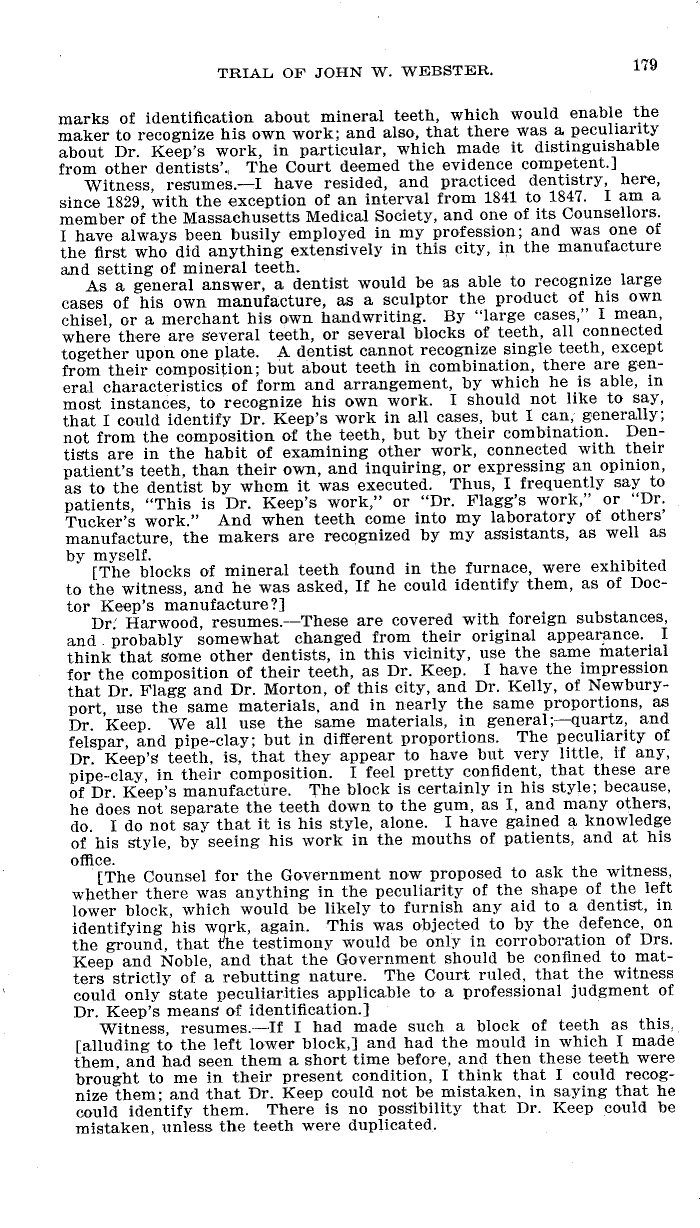|
TRIAL OF JOHN W. WEBSTER. 179
marks of identification about mineral teeth, which would enable the
maker to recognize his own work; and also, that there was a peculiarity
about Dr. Keep's work, in particular, which made it distinguishable
from other dentists'.; The Court deemed the evidence competent.]
Witness, resumes.-I have resided, and practiced dentistry, here,
since 1829, with the exception of an interval from 1841 to 1847. I am a
member of the Massachusetts Medical Society, and one of its Counsellors.
I have always been busily employed in my profession; and was one of
the first who did anything extensively in this city, in the manufacture
and setting of mineral teeth.
As a general answer, a dentist would be as able to recognize large
cases of his own manufacture, as a sculptor the product of his own
chisel, or a merchant his own handwriting. By "large cases," I mean,
where there are several teeth, or several blocks of teeth, all connected
together upon one plate. A dentist cannot recognize single teeth, except
from their composition; but about teeth in combination, there are gen-
eral characteristics of form and arrangement, by which he is able, in
most instances, to recognize his own work. I should not like to say,
that I could identify Dr. Keep's work in all cases, but I can; generally;
not from the composition of the teeth, but by their combination. Den-
tists are in the habit of examining other work, connected with their
patient's teeth, than their own, and inquiring, or expressing an opinion,
as to the dentist by whom it was executed. Thus, I frequently say to
patients, "This is Dr. Keep's work," or "Dr. Flagg's work," or "Dr.
Tucker's work." And when teeth come into my laboratory of others'
manufacture, the makers are recognized by my assistants, as well as
by myself.
[The blocks of mineral teeth found in the furnace, were exhibited
to the witness, and he was asked, If he could identify them, as of Doc-
tor Keep's manufacture?]
Dr: Harwood, resumes.--These are covered with foreign substances,
and . probably somewhat changed from their original appearance. I
think that some other dentists, in this vicinity, use the same material
for the composition of their teeth, as Dr. Keep. I have the impression
that Dr. Flagg and Dr. Morton, of this city, and Dr. Kelly, of Newbury-
port, use the same materials, and in nearly the same proportions, as
Dr. Keep. We all use the same materials, in general; quartz, and
felspar, and pipe-clay; but in different proportions. The peculiarity of
Dr. Keep's teeth, is, that they appear to have but very little, if any,
pipe-clay, in their composition. I feel pretty confident, that these are
of Dr. Keep's manufacture. The block is certainly is his style; because,
he does not separate the teeth down to the gum, as I, and many others,
do. I do not say that it is his style, alone. I have gained a knowledge
of his style, by seeing his work in the mouths of patients, and at his
office.
[The Counsel for the Government now proposed to ask the witness,
whether there was anything in the peculiarity of the shape of the left
lower block, which would be likely to furnish any aid to a dentist, in.
identifying his wqrk, again. This was objected to by the defence, on
the ground, that the testimony would be only in corroboration of Drs.
Keep and Noble, and that the Government should be confined to mat-
ters strictly of a rebutting nature. The Court ruled, that the witness
could only state peculiarities applicable to a professional judgment of
Dr. Keep's means of identification.]
Witness, resumes.-If I had made such a block of teeth as this;
[alluding to the left lower block,] and had the mould in which I made
them, and had seen them a short time before, and then these teeth were
brought to me in their present condition, I think that I could recog-
nize them; and that Dr. Keep could not be mistaken, in saying that he
could identify them. There is no possibility that Dr. Keep could be
mistaken, unless the teeth were duplicated.
|

